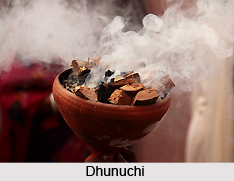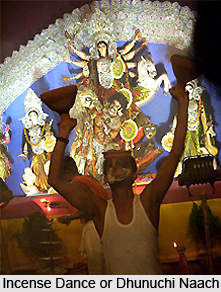 Incense dance also called `Dhunuchi Naach` is a popular dance of West Bengal which is usually performed during Durga Puja. The dance has originated from some occult rites. The speciality of incense dance is it is done with effervescent smoke.
Incense dance also called `Dhunuchi Naach` is a popular dance of West Bengal which is usually performed during Durga Puja. The dance has originated from some occult rites. The speciality of incense dance is it is done with effervescent smoke.
The incense dance is also called as devotional folk dance where performers as well as watchers participate with equal fervour. Men, women, old and young, everyone dances to the rhythm of drums that are played along with the incense dance.
Performance of Incense Dance
Incense dance is performed usually during Hindu festivals like Durga Puja. In this dance, each dancer or devotee holds earthen incense containing burning charcoal in one hand. Each time the dance begins, the dancer flings some handful of incense into the earthen vase. Few of them stand outside the ring and continuously supply the incense. As the dancers dance with the earthen vase, fire and smoke leap up with sudden vigour.
 Dancers perform this dance on the Navami day in front of the idol of Goddess Durga accompanied with the sound of dhak, the traditional drums. Generally, varieties of drums are used to create a devotional and trance like atmosphere. The drummers accompany the dancers with their beats - sometimes slow, sometimes fast. The dancers dance gracefully throughout night chanting mantras. After the ritual burning of the incense, all the dancers join hands and dance around in a circle for sometime before concluding the performance.
Dancers perform this dance on the Navami day in front of the idol of Goddess Durga accompanied with the sound of dhak, the traditional drums. Generally, varieties of drums are used to create a devotional and trance like atmosphere. The drummers accompany the dancers with their beats - sometimes slow, sometimes fast. The dancers dance gracefully throughout night chanting mantras. After the ritual burning of the incense, all the dancers join hands and dance around in a circle for sometime before concluding the performance.
Techniques of Incense Dance
The dancers pick up the pot in one of their hands, usually right one and perform in front of the deity by matching steps with the drum. Some of the dancers prefer to pick up two pots. And those who are quite pro in this dance, pick up three; two by both hands and another by teeth. This technique requires great balance.
Design of Dhunuchi
Dhunuchi basically is a pot which has a funnel base with an open top to insert inflammable items. The pot is filled with blazing coconut coir shells, further mixed with powdered incense locally called Dhuno to start the proceedings.
Traditionally, earthenware is used to make Dhunuchi. But it can also be made using various metals like brass or silver. When it is made of metal, it needs a longer handle because of the heat. It is lit by placing burning coal at the bottom, which ignites a layer of slow-burning coconut husk, on which incense is spread.
The incense dance is not limited to West Bengal only. It is also performed in various other states of India as many Bengalis reside outside of Bengal as well.



















